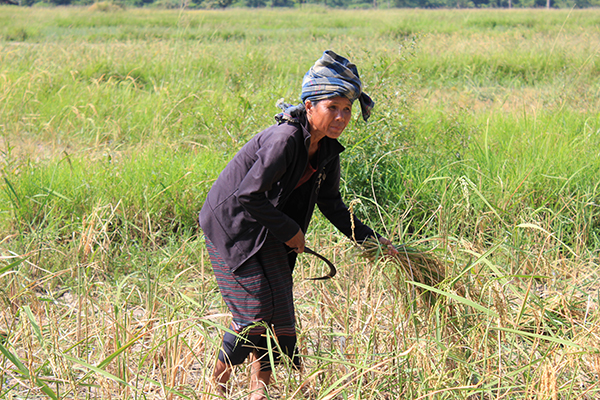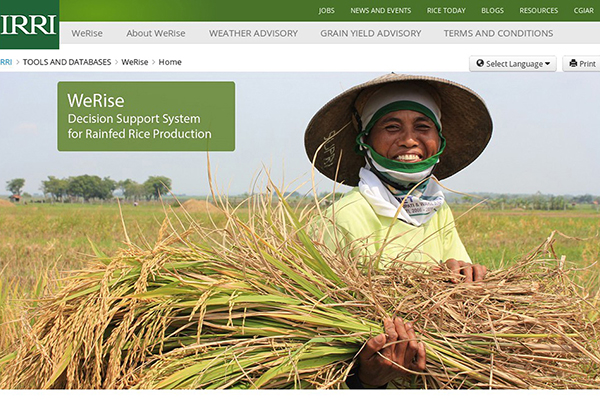
Unreliable weather can make or break rice farmers that rely on rainfall for water. Climate change makes it even harder to predict weather conditions, thus lowering the chances of recovering farmers’ investments in mitigating the impact of erratic rainfall patterns on their crops. To help solve this problem, a prototype weather rice-nutrient integrated decision support system (WeRise) came about. WeRise is a web application tool that integrates rice nutrients with weather data to provide farmers with weather and crop advisories.

Rice roulette
Growing rice in rainfed environments is like gambling. It is difficult for farmers to decide when to sow or transplant rice because they cannot predict the arrival of the monsoon. They also cannot foresee whether the season’s rainfall will be enough to sustain their crops. Even with sufficient rainfall at the beginning of the season, they have no guarantee the rain will continue. Obviously, too much or too little rainfall can lead to a poor harvest. The weather can also inflict damage during harvest time. If harvesting coincides with rains, farmers need plastic sheets to keep grains dry. The bottom line is that no one can tell how much of their investment can be recovered after a cropping season.
Optimal production can be achieved through good agricultural practices, which can be designed to fit the different types of rainy season. For example, a long-cycle rice variety should be chosen for long rainy seasons with sufficient rainfall. In areas where the rainy season is short, a short-cycle variety is suitable for coping when water is scarce. If the rainy season is long enough but rainfall is insufficient, a drought tolerant rice variety can be a good candidate.
When drought occurs, a short-cycle variety should be used to avoid water shortage at the critical stages of plant growth. However, these decisions are made at the start of the planting season. Farmers cannot change the variety of their choice after they have planted it.
Tailor-made weather and yield reports
WeRise is a product of collaboration between the International Rice Research Institute (IRRI) and Japan on the project Climate Change Adaptation in Rainfed Rice Areas (CCARA). WeRise aims to improve the chances of farmers of having good rice yields even with unpredictable weather patterns. Japan’s Ministry of Agriculture, Forestry and Fisheries funds CCARA.
WeRise provides crucial weather and grain yield advisories in the form of a narrative summary. This includes the start and end of the rainy season, the expected rainfall distribution and flooding or drought that might occur during the season, when to sow and transplant the crop, what variety is appropriate, and how to apply fertilizer efficiently. It also contains graphical outputs of rainfall, minimum and maximum temperatures, wind speed, vapor pressure, and solar radiation.
These sets of information are location-specific to subdistrict levels of countries in Southeast Asia. The seasonal weather predictions are based on the localized outputs of the Scale Interaction Experiment-Frontier (SINTEX-F) Research Center for Global Change developed by Japan’s Agency for Marine-Earth Science and Technology. SINTEX-F is designed to predict when the El Niño Southern Oscillation will occur, 1 to 24 months in advance. Thus, WeRise can provide farmers with predicted weather and yield information with enough lead time for them to prepare and decide what and when to plant.
WeRise can also predict yield based on recommended sowing and fertilizer application timings using the ORYZA crop modeling tool, which simulates the growth and development of rice as well as water under different conditions, including local weather. The grain yield advisory is also location-specific so that end-users can choose a subdistrict for this advisory.
From theory to field reality
In rainfed rice farming, the timing of sowing is crucial because good yield is linked to a sufficient water supply and good crop growth. Some farmers plant early while others are more cautious and start sowing late in the monsoon. Relying mostly on guesswork, farmers can have high or low yields as a result of coincidence; thus, they cannot obtain the same result in the following year.
In 2014, WeRise was tested in Indonesia to see whether it could minimize the effect of poor timing. Although many farmers started sowing rice after a downpour at the beginning of the rainy season, the WeRise team, following its weather prediction, planted rice much later.
A few weeks after the farmers planted, rainfall stopped. The young rice seedlings planted by the farmers suffered from water scarcity and some plants did not survive. The WeRise team, on the other hand, obtained significantly higher yield than the farmers who did not receive any weather advisory and relied on their instincts.

A user-friendly tool
WeRise is designed for agricultural extension agents and farmers who can access the Internet through smartphones or computers. Local millers and retailers of agricultural inputs are potential users who can be sources of information for farmers with no Internet access. WeRise is now available in English, Bahasa, and Lao, making information dissemination even simpler for small-scale rice farmers who are not tech-savvy.
The feedback from 53 research and extension workers in Indonesia, Lao PDR, and the Philippines has been positive. They found WeRise easy to use and understand. They also said that explaining the advisory to farmers was easy.
“The information is more complete and it has graphs,” said Beby Noviani, an extension worker from Indonesia.
Muhammad Jono, another Indonesian extension worker, summed up his experience with WeRise in one word: “simple.”
Raising farmers’ odds
With WeRise, rice farmers will be able to use their resources efficiently by choosing a suitable variety, avoiding a failure in crop establishment, and using an efficient fertilizer application. This can help reduce their risks and make rainfed rice farming better and more stable. By providing farmers with timely, accurate information, farmers can enjoy better harvests, which translate into higher earnings and more reliable profitability. Thus, WeRise could make rainfed rice farming attractive to young people by changing the perception that rainfed agriculture is an all-or-nothing occupation.
![]() Drs. Hayashi and Ishimaru are seconded scientists from the Japan International Research Center for Agricultural Sciences (JIRCAS) working on the CCARA project. Dr. Hayashi is the project coordinator who leads the agronomy and soil science component. Dr. Ishimaru is a plant breeder who leads the genetics and breeding component. Dr. Boling is a former postdoctoral fellow of CCARA.
Drs. Hayashi and Ishimaru are seconded scientists from the Japan International Research Center for Agricultural Sciences (JIRCAS) working on the CCARA project. Dr. Hayashi is the project coordinator who leads the agronomy and soil science component. Dr. Ishimaru is a plant breeder who leads the genetics and breeding component. Dr. Boling is a former postdoctoral fellow of CCARA.





